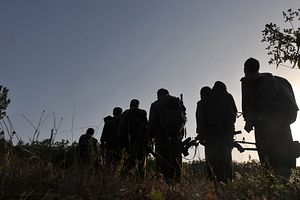There is a game children play where one thinks of a sentence and whispers it into the ear of another. The second child listens and then repeats the phrase to the next. We call it telephone in the United States, and the result is always the same: the original phrase is changed with each ear that hears it. The final sentence is often completely unlike the original.
Figuring out how many Central Asians are fighting with ISIS is like a game of telephone, complicated by multiple voices doing the whispering, misquoted and misreported figures, and deliberate misinformation from both ISIS and Central Asian governments.
A report last week from Daniil Turovsky, a correspondent for the Riga-based Meduza which launched an English-language site in February, that was republished on the Guardian, had two numbers regarding Central Asians fighting with ISIS that serve to focus this confusion. What is likely a simple error, an oversight by the author and editors, nonetheless contributes to a cacophony of estimates. The subhead of the Guardian piece says that “[u]p to 4,000 central Asian migrants are said to have travelled to Syria after being recruited by Chechens in Moscow.”
The piece itself focuses on the story of Loik Rajabov, a Tajik who lived in Russia as a migrant worker and in 2014 moved to Syria to join ISIS with his wife and children. Incidentally, it has been reported today that Rajabov was been killed in fighting near Aleppo. Using Rajabov’s story to illustrate what some see as a larger trend, Turovsky later in the piece says:
In a recent report, the International Crisis Group said that in the last three years, between 2,000 and 4,000 people have travelled to Syria from Tajikistan.
The ICG report referenced, which some Central Asia researchers have called into question, uses the 2,000-4,000 range for all of Central Asia (corresponding to the Guardian piece’s first numerical statement). The ICG report’s footnotes indicate, to some extent, the source of their numbers:
Western officials estimate that about 400 fighters from each of the five Central Asian countries have travelled to join the Islamic State. A Russian official put the total regional figure at 4,000.
Edward Lemon, a PhD student at Exeter who tracks Tajiks that have joined ISIS, said in a March interview with RFE/RL that he has found evidence online of about 70 Tajiks fighting in Syria. He comments that there are likely more which media have not picked up on, but the upper range of his estimate is 200. And this week, the Interior Minister of Tajikistan finally put a number on the government’s estimate: 386.
So is it 70, 200, 386, 400, 2,000, or 4,000?
John Heathershaw and David W. Montgomery, authors of a skeptical report questioning the link between Islamization and radicalization, wrote a blog in February titled “Who Says Syria’s Calling? Why It Is Sometimes Better to Admit That We Just Do Not Know.”
Numbers matter. Central Asian government use such statistics to tighten their grip on power, cutting off dissenting voices, disappearing troublesome individuals and winning military, economic, and political support from their allies.
In April, Russia announced it was prepared to give Tajikistan $1.2 billion in military assistance because, as RT put it, the country “is currently threatened by invasion from the Islamic State.” Uzbekistan has also made the claim that it is threatened by invasion through Turkmenistan–which broke from its stated policy of neutrality to ask the U.S. for possible military assistance earlier this year. Hyperbole leads to bad policy and, in the case of many Central Asian states, human rights violations.
Are there Central Asian’s fighting with ISIS? Most definitely. How many? It’s difficult to say and perhaps best not to speculate.
































